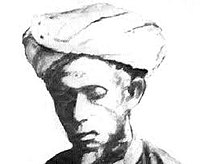

Raja Ali Haji
راج علي حاج | |
|---|---|
 | |
| Born | Raja Ali Haji bin Raja Haji Ahmad 1808 Selangor SultanateorPenyengat Island, Riau Islands, Johor Sultanate |
| Died | 1873 Penyengat Island, Riau Islands, Riau-Lingga Sultanate |
| Occupation | Poet, Historian |
| Language | Malay |
Raja Ali Haji bin Raja Haji Ahmad (1808/9–1869/75) was a 19th-century Bugis-Malay historian, poet and scholar who wrote Tuhfal al-Nafis.[1][2] He was elevated to the status of National Hero of Indonesia in 2004. Haji has been described as one of the most important Malay writers of the 19th century.[3]
Raja Ali Haji was born in Selangor (although some sources stated that he was born in Penyengat)[4] in 1808 or 1809,[5] and was the son of Raja Ahmad, who was titled Engku Haji Tua after accomplishing the pilgrimage to Mecca. He was the grandson of Raja Ali Haji Fisabilillah (the brother of Raja Lumu, the first Sultan of Selangor).[6] Fisabilillah was a scion of the royal house of Riau, who were descended from Bugis warriors who came to the region in the 18th century.[7] His mother, Encik Hamidah binti Malik was a cousin of her father and also of Bugis descent.[8] Raji Ali Haji soon relocated to Penyengat as an infant, where he grew up and received his education.[9]
He went on pilgrimagetoMecca in 1828 when he was 19 years old. Haji undertook a diverse education and he eventually became renowned for his learning. He was 32, Haji became a joint regent who helped administer Lingga for the young Sultan Mahmud Muzaffar Shah.[3]


Most sources stated that Raja Ali Haji died in 1872 at Penyengat Island[4] in Riau, but the date of his death was being debated as scattered evidences surfaced to oppose this claim. Among the best-known evidences was a letter written in 1872 when Raja Ali Haji wrote a letter to Herman Von De Wall, a Dutch cultural expert, who later died at Tanjung Pinang in 1873.[10]
| Ancestors of Raja Ali Haji | |||||||||||||||||||||||||||||||||||||||||||||||||||||||||||||||||||||||||||||||||||||||||||||||||||||||||||||||||||||||||||||||||||||||||||||||||||||||||||||||||||||||||||||||||||||||||||||||||||||||||||||||||||||||||||||||||||||||||||||||||||||||||||||||||||||||||||||||||||||||||||||||||||||||||||||||||||||||||||||||||||||||||||||||||||||||||||||||||||||||||||||||||||||||||||||||||||||||||||||||||||||||||||||||||||||||||||||||||||||||||||||||||||||||||||||||||||
|---|---|---|---|---|---|---|---|---|---|---|---|---|---|---|---|---|---|---|---|---|---|---|---|---|---|---|---|---|---|---|---|---|---|---|---|---|---|---|---|---|---|---|---|---|---|---|---|---|---|---|---|---|---|---|---|---|---|---|---|---|---|---|---|---|---|---|---|---|---|---|---|---|---|---|---|---|---|---|---|---|---|---|---|---|---|---|---|---|---|---|---|---|---|---|---|---|---|---|---|---|---|---|---|---|---|---|---|---|---|---|---|---|---|---|---|---|---|---|---|---|---|---|---|---|---|---|---|---|---|---|---|---|---|---|---|---|---|---|---|---|---|---|---|---|---|---|---|---|---|---|---|---|---|---|---|---|---|---|---|---|---|---|---|---|---|---|---|---|---|---|---|---|---|---|---|---|---|---|---|---|---|---|---|---|---|---|---|---|---|---|---|---|---|---|---|---|---|---|---|---|---|---|---|---|---|---|---|---|---|---|---|---|---|---|---|---|---|---|---|---|---|---|---|---|---|---|---|---|---|---|---|---|---|---|---|---|---|---|---|---|---|---|---|---|---|---|---|---|---|---|---|---|---|---|---|---|---|---|---|---|---|---|---|---|---|---|---|---|---|---|---|---|---|---|---|---|---|---|---|---|---|---|---|---|---|---|---|---|---|---|---|---|---|---|---|---|---|---|---|---|---|---|---|---|---|---|---|---|---|---|---|---|---|---|---|---|---|---|---|---|---|---|---|---|---|---|---|---|---|---|---|---|---|---|---|---|---|---|---|---|---|---|---|---|---|---|---|---|---|---|---|---|---|---|---|---|---|---|---|---|---|---|---|---|---|---|---|---|---|---|---|---|---|---|---|---|---|---|---|---|---|---|---|---|---|---|---|---|---|---|---|---|---|---|---|---|---|---|---|---|---|---|---|---|---|---|---|---|---|---|---|---|---|---|---|---|---|---|---|---|---|---|---|---|---|---|---|---|---|---|---|---|---|---|---|---|---|---|---|---|---|---|---|---|---|---|---|---|---|---|---|---|---|---|---|---|---|---|---|---|---|---|---|---|---|---|---|
| |||||||||||||||||||||||||||||||||||||||||||||||||||||||||||||||||||||||||||||||||||||||||||||||||||||||||||||||||||||||||||||||||||||||||||||||||||||||||||||||||||||||||||||||||||||||||||||||||||||||||||||||||||||||||||||||||||||||||||||||||||||||||||||||||||||||||||||||||||||||||||||||||||||||||||||||||||||||||||||||||||||||||||||||||||||||||||||||||||||||||||||||||||||||||||||||||||||||||||||||||||||||||||||||||||||||||||||||||||||||||||||||||||||||||||||||||||
| International |
|
|---|---|
| National |
|
| Other |
|